Miniature horses are the interest of many horse lovers. There are many misconceptions and questions about these horses floating around. Some considered as a pony or some considered as a breed. But in a single word, Miniature horses are the smaller version of larger horse breeds developed for some specific purposes. The horses are mainly bred selectively for smaller sizes like Clydesdale, Arabian, or Shetland ponies. Other horse breeds like American Paint and Appaloosa horses are selectively bred for the color pattern.
The Miniature Horse is the small horses that have selectively bred for centuries and developed in the present size. The horses are the smaller sizes of the original breed in mini form. Miniature horses are also known as “minis.” Miniature horses are mainly bred for pet animals as the large horses are costly to maintain. The average height of miniature horses is 36-38 inches and depending on the breed registry.
Why Do You Need To Know About Miniature Horse
Miniature horses are one of the most popular pets to horse lovers. You can do many things with minis. You can use this as companion animals, assisting disabled persons, in showing purpose, equine therapy, different competitions, and equine evolution studies. As a horse owner or lover, you naturally curiosity about the characteristics, behavior, breeding, care & management, versatile uses, and health problems. In my article, I shall highlight most of the interesting facts on the miniature horse for your easy understanding, and you will most of the answers to your question.
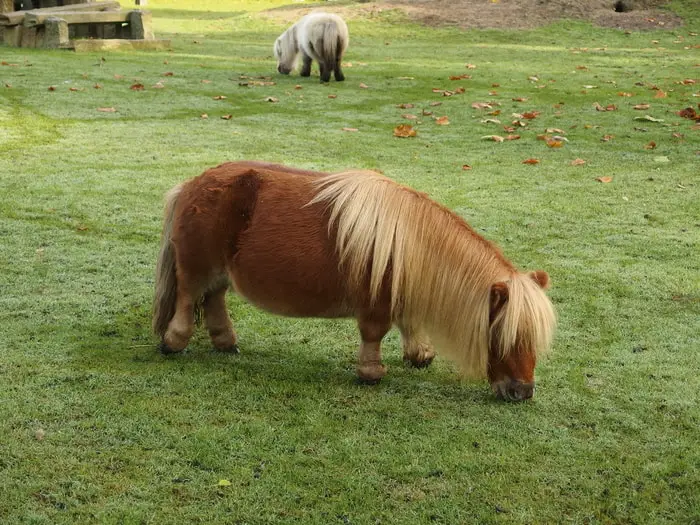
1. History and Origin
Miniature horses were first developed in Europe in the 16th century and become popular pets due to nobility. The horses were widely used for mine works as child labor was banned. The horse was developed by selective breeding for centuries for their size, sought legs, weight-bearing capacity, low maintenance cost, and disease susceptibility. The horses were brought to the United States of American in the 19th century. The horses were also used for mine works at that period. Later, in the 20th century, the miniature became popular as pets, nobility, companion, or assisting animals to horse lovers.
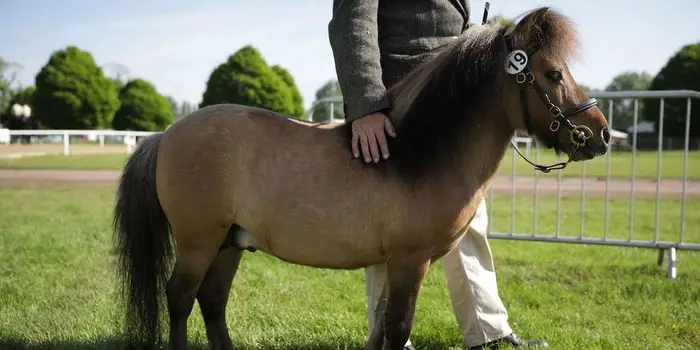
2. How Big is a Miniature Horse?
Miniature horses of minis are measured in inches or centimeters instead of hands. According to the American Miniature Horse Association (AMHA), the horses should be 34 inches (8.5 hands) or less. The American Miniature Horse Registry recognizes to divisions of Minis: Division A (34 inches) and Division D (38 inches). The average weight of the miniature is 150 to 350 pounds.

3. How Long Do Mini Horses Live?
The lifespan of minis is more than healthy horses. The average lifespan of miniature horses is 25 to 35 years. They are hardy, durable, less disease susceptible, and require less care. However, the minis are suffered from a few health problems like dwarfism, obesity, reproductive problems, and digestive system disorders like colic.
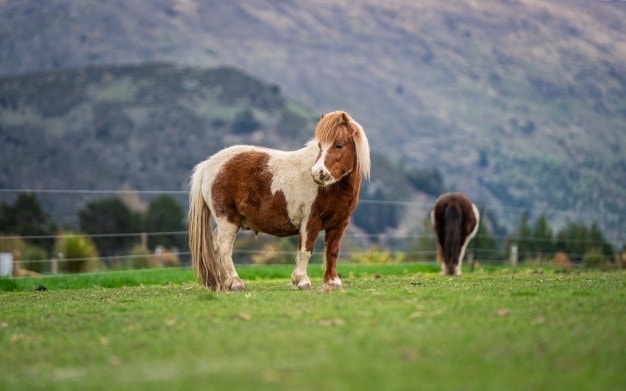
4. Miniature Horse Breeds
Miniature horses are developed as same as their counterpart large horse by selective breeding. Falabella is the first horse breeds that bred into Miniature form in Argentina in mid-1800 by Petrick Newtall. At present, the Arabian, Palomino, Pinto, American Quarter Horse, Thoroughbred, and many other breeds were found in miniature versions. Day by day, the popularity of minis is increasing due to their versatile uses and advantages.

5. Registration of Horses
According to AMHA, any horse under 34 inches of height can be registered as a miniature horse. A “Minis” should be small, well-balanced, energetic, agile, playful, and alert. AMHA register any horse under 34 inches irrespective of color, breed, eye color, and marking. Juvelines are given a temporary registration at the age of 3 and permanent registration at the age of 5. The registration at AMHA is quite expensive.

6. Breeding of Horse
Miniature horses can be bred like ordinary horses. They are bred for their outstanding disposition and excellent conformation. The gestation period is approximately eleven months (330 days). The birth weight of miniature foal is about 12 to 25 pounds. The horses grow to 90 adult height and size within the first years of life. The foals are typically grown up with as usual care and weaning at the age of 4-5 months. Juvelines are considered “junior” horses up to 2 years, and the horses over three years are called “seniors.”

7. Color and Marking of Minis
The miniatures are found in every horse color and marking. They can be in a solid color, spotted like Appaloosa, a pattern like Pinto or American Paint Horse. The coat is thicker than the ordinary horses. The mane and tail are thicker than the larger horses as per the size of the body.
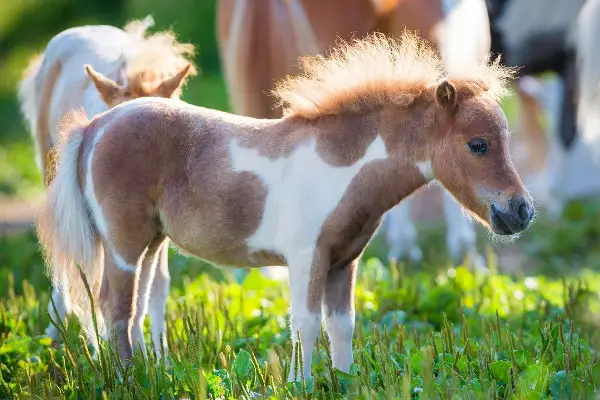
8. Are mini horses easy to care for?
Miniatures are popular as pets to all horse lovers. They need less care, less feed, less space, and more disease resistant. They also require less deworming dose, less medicine, and smaller horse tacks. They require special attention in grooming and hoof care.
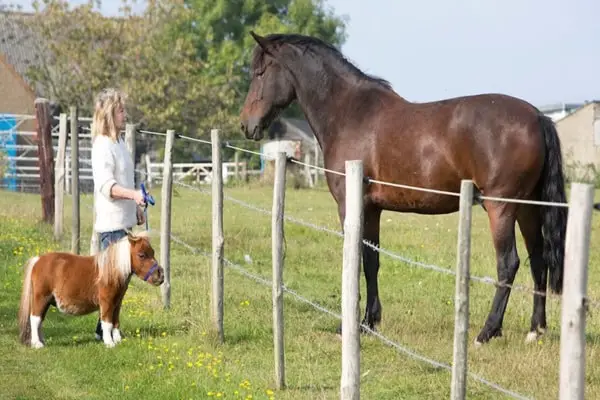
9. Diet and Nutrition
The miniatures require a balanced diet like other horses with protein, carbohydrates, fats, vitamins, and minerals. The ordinary feed of miniatures is grass, hay, oats, gram or cowpeas, barley, and vitamin and mineral supplements. The miniatures are prone to overfeeding due to their small size. You must be very careful during feeding. The significance of digestive problems is more in “Minis” like colic, indigestion, and diarrhea. You may take expert advice and ration formulation for your horse from an equine vet.
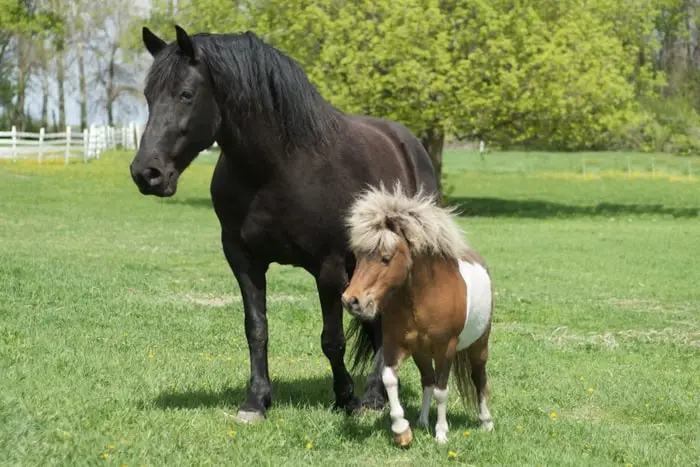
10. Unique Characteristics
Miniature horses are an excellent pet for horse lovers. The horses are famous for their size and color pattern. The miniatures are bred selectively from the original horse through inbreeding. The horses do not require ample space or stable and extra care.

11. What can you Do with a Miniature Horse?
Miniature horses are bred and reared for a variety of reasons. It is a common question among the horse lover that what I can do with miniatures. The versatile uses of miniatures are:
- They are used as excellent pets to many horse lovers.
- Miniatures are used as companion animals with elderly and lonely people as they can be maintained easily than dogs and cats.
- They are widely used in Equine therapy for physically and mentally disabled persons.
- They are widely used in horse shows offered by registers.
- Miniatures are used for different shows, including halter, driving, in-hand halter and jumper, liberty, obstacle crossing, and showmanship.
- Miniatures are easily trained to work indoors and as well as outdoor activities.
- You can breed miniatures as a matter of investment and sell to lover lovers.
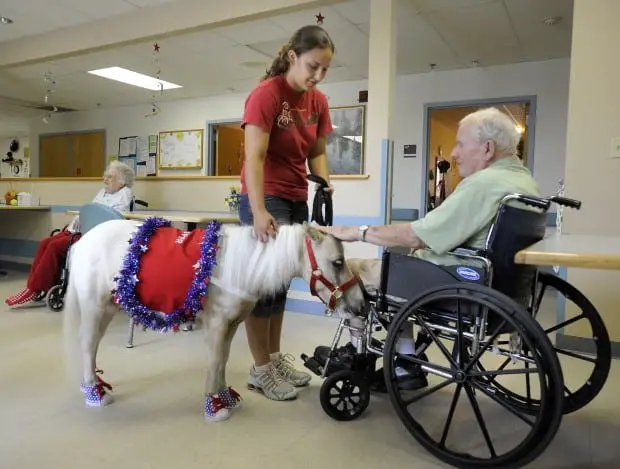
12. Health Problems of Miniature Horse
Though miniatures have many benefits and positive values, they are stuffed from a few health problems. The health problems due to their smaller size, inbreeding, and selective breeding. The common health problems are:
a. Obesity. Obesity is one of the common health problems of miniature horses. Many a time, the owner becomes careless, and the horse takes excess food.
b. Dental Issue. The miniatures are dwarf than the average horse, and their head is smaller in size. The dental formula is the same as the giant horse. The teeth are fixed in a smaller place, and there is a chance of more erosion. Overbites and underbites of teeth is a common issue of minis. This dental problem leads to digestive problems like feed engorgement, indigestion, colic, and weakness.
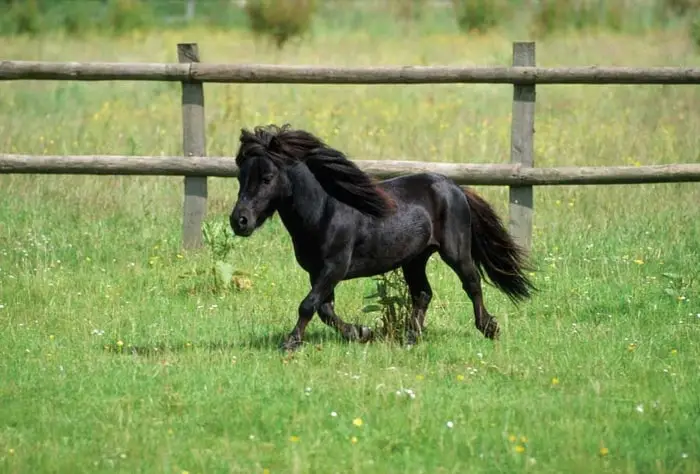
c. Colic. Miniatures have an excellent appetite and eat excess diet when getting a chance. Moreover, they are prone to dental problems at any stage of life. Due to overfeeding and dental problems, they cannot chew feed properly, and digestive problems arise like colic, interstitial engorgement, accumulation gas in the stomach and intestine, and death.
d. Hyperlypemia. Miniatures, small horses, and ponies have more metabolic capability than larger horses. During the period of stress, lactation, late pregnancy, and any other cases when there is a high energy requirement, fat metabolism occurs. In this case, the excess amount of fat circulates in the blood and hyperlipemia occurs.
e. Reproductive Problems. The miniatures uterus is comparatively smaller. The reproductive problems like dystocia, retention of the placenta are more than the healthy horses. Moreover, congenital abnormalities are also more in these breeds.
f. Eclampsia. Eclampsia is a severe problem in miniatures which rarely seen in large horses. There is a severe drop in systemic calcium during the later stage of pregnancy and the early lactation stage. Calcium is necessary for the normal functioning of the muscles. The signs of calcium deficiency are dilatation of the pupil, muscular tremor, anxiety, colic, bloat, sweating, progressive recumbency, and death.
g. Foaling. The birth weight of miniature foals around 20 pounds. Due to their smaller size, they require extra care and attention with some special equipment. Miniature foals are suffering from few congenital anomalies like limb deformities, conformation problems like a toe in and toe-out, tendon contracture, tendon laxity, and heart problems.
13. Popular Miniature Horses
Miniatures are becoming popular due to their exceptional size, conformation, and multidimensional uses. They are used in many popular TV shows, miniature horse competitions, jumping, halter, trail racing, and showmanship. The national miniature show arranges every year in September.
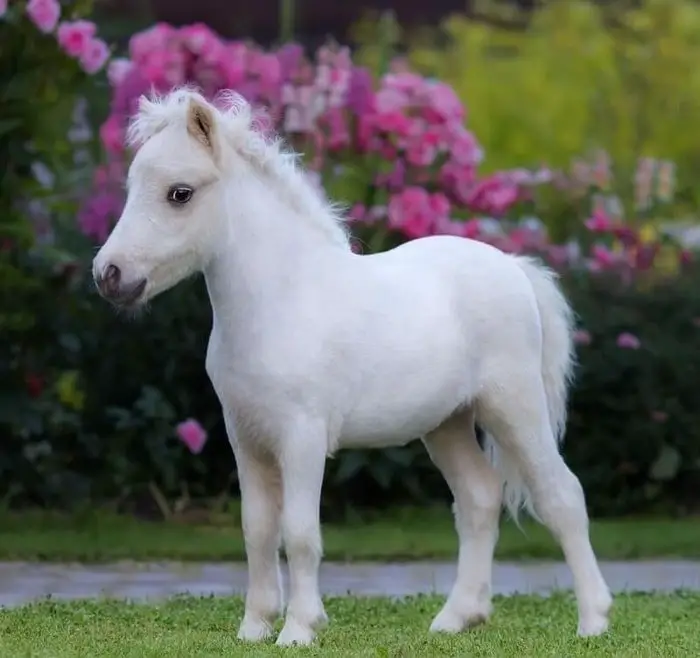
14. Do Miniature Horses Make Good Pets?
Yes, you can adopt a miniature as the right pet for your house. The advantages I have discussed earlier, they need very little care and management than other pets like dogs and cats. Moreover, you will require less expense for food and medicine. The life expectancy is more than other parts. You can use companion animals, assisted animals for physically disabled persons, and use it in competitions. You can use miniatures as a source of income by breeding and showing.
Concluding Remarks
Miniatures are the popular horse types in the present day. The excellent conformation, different size, advantages over larger horses, multiple uses, and excellent companion animals makes them accessible to horse lovers. You will feel proud to have become the owner of a “Minis.” At the same time, you must be cautious about the horse abuse to bred it into miniatures. In my article, I have tried to answer all possible questions of your mind. If you are satisfied with the information, please share it with your friends.